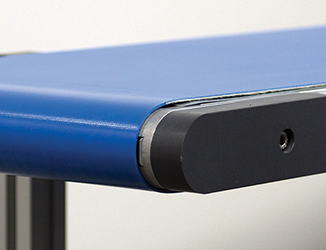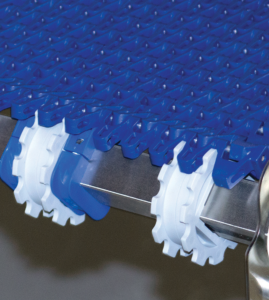
Conveyor belt tracking: Best practices & methodology
Mike Edwards
Features best practises white paper
Conveyor systems are the backbone of industry and are found in many facilities around the globe. Without them, production, testing, assembly, and shipping would come to a screeching halt.
One of the most common issues that impacts conveyor operation is belt misalignment and tracking problems. Belt tracking issues occur when the conveyor belt does not run true on the conveyor frame, causing it to drift to one side or the other. This can result in the belt fraying, which will eventually lead to premature belt failure. Belt failure renders the conveyor inoperable until a replacement belt can be installed, impacting productivity and resulting in lost time and revenue. Additionally, belt failure can cause damage to peripheral equipment around the conveyor.
To overcome the issues posed by conveyor belt misalignment, it is critical to ensure that your conveyors are designed with adequate belt tracking protocols in mind.
Types of Conveyor Drives
Many kinds of conveyors use belts as the conveyor surface. Conveyor belts fall into two very distinct categories:

The sprockets (gray) on a square drive shaft engage with features of the plastic modular belt (dark blue); which pull the belt forward in this positive drive plastic-modular belt conveyor example.
1) Positive Drive Conveyor Belts
Positive drive belt conveyors rely on the use of sprockets or pulleys which engage with features on or within the belt to propel the belt forward. Several types of conveyors fall into this category: chain, timing belt, plastic modular belt, and wire mesh.
Due to the nature of the positive drive and the need for the belt to engage with the sprocket or pulley, these types of conveyors are less likely to suffer from belt alignment issues. However, in certain application and construction scenarios, alignment issues can still occur.
2) Friction Drive Conveyor Belts
Friction drive belt conveyors rely on the friction between the underside of the belt and the surface of the drive pulley to propel the belt forward. These types of conveyor belts typically are designed with the friction drive in mind. To facilitate the friction, the bottom surface structure of the belt may vary from the upper surface.
These belts can be single, double, or triple-ply, and are made in a variety of materials including polyurethane, polyvinyl-chloride (PVC), and polyester. Additionally, it is possible for the belt running surface, or underside, to be a different material than the top surface. The top surface of the belt can be smooth or raised, coated or non-coated, or it can have a rough-top. Some models even feature lateral cleats or longitudinal sidewalls.
Regardless of the belt material or where the drive is positioned on the conveyor, at the end or in the centre, the design and build of the conveyor frame, including its rollers, is a fundamental element in ensuring belt tracking efficiency.
Conveyor Design for Belt Tracking
Conveyors are constructed in three main parts: the drive, the idler(s), and the intermediates. The design and construction of these three components are critical to ensure safe and efficient belt tracking.
Drives and Idlers
The drive and idler assemblies consist of drums, bearings, shafts, roll holders, and in the case of the drive, a motor mount. Of all these components, the drums are the most vital aspect of the belt tracking process.
The Intermediates
The intermediates are the sections of conveyor between the infeed and the outfeed. Intermediates are sometimes referred to as “the conveyor frame.”
The intermediate provides structural integrity to the conveyor as well as the main surface that the belt travels upon. Additionally, depending on the width and length of the conveyor, the intermediate may also have rollers or other supports to hold the belt as it moves along the underside of the conveyor to minimize belt sag.
Frame Construction and Belt Materials
The intermediate should be designed and assembled so that the frame runs true and square, and it should also be installed in a manner that supports frame rigidity. The surface across which the belt rides can be a roller bed or slider bed assembly. Since the surface that the belt rides on needs to be low in friction and as economical as possible, the use of roller beds has fallen out of favour. More recent slider bed models are made from sheet steel, either stainless or galvanized, although roller beds are still common in some industries.
The material on the underside of the belt should be considered when selecting the slider bed material to ensure strength and durability. Additionally, the top material and surface finish of the belt should be a concern when selecting belt return supports or rollers. Each of these components play a significant role in the tracking of the conveyor belt.
Belt Manufacturers Agree: Trapezoidal Crown Pulleys are the Way to Go
In a review of the technical resources put forth by the major U.S. belting manufacturers, the overwhelming consensus as to the proper way to track a conveyor belt is by using trapezoidal crowned pulleys.
This article is an excerpt from a white paper contributed by mk North America, Inc. To download the complete white paper, or to continue reading, click here.
Print this page